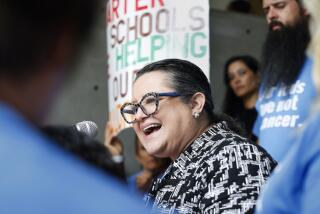Where change begins
The freshman-only academies of Animo Locke 1 and 2 are crammed into rows of rundown portable classrooms on separate campuses. Their courtyards are parking lots. Cafeterias? Folding benches under tarps on the blacktop. The students arrive from Watts middle schools that left them unprepared for algebra, which, according to California’s curriculum goals, they were supposed to take in eighth grade.
These two academies, and three others like them, represent the future of the Green Dot charter takeover of Locke High School. Right now, the school is dominated by two larger academies, 800 students each, for students in 10th through 12th grades. The plan is to phase them out as classes graduate. As they shrink, the ninth-grade academies will grow into full high schools, adding new freshmen each year.
Green Dot has promised to educate a new generation of Watts students who not only graduate, but graduate ready for college. A visit to its freshman academies, however, shows that major gains don’t come easy, or fast.
So far, not a single student at Locke 1 has tested as proficient on the school’s benchmark exams in algebra. Locke 2 is in similar straits. Students disappeared during the school year; new students with their own difficulties signed up. These are the same intractable problems Locke suffered from as an L.A. Unified school.
Previous Green Dot charters, opened as alternatives to failing public schools, attracted motivated families that came from far-flung communities to place their children on waiting lists. As a result, enrollment was predictable and stable. At Locke, Green Dot took over an already cramped and rundown campus and committed to accepting students within its enrollment area -- which has meant taking more than it has room for, and enrolling students who are less interested in what Green Dot has to offer.
To this educational experiment, Green Dot is applying its formula for student success: small academies, uniforms, tight security, college-prep curriculum for all, passionate young teachers, autonomous campuses. L.A. Unified teachers who disdain charter schools have predicted that this formula will come up short when it has to contend with some of the worst-prepared students from one of the city’s most crime- and poverty-burdened neighborhoods.
It will take years to determine which side is closer to the truth. At this point, there have been humbling lessons for both. Green Dot has proved that Locke can be an orderly and safe school. Truancy, graffiti and drug use have dropped dramatically. The staff’s dedication is obvious; students almost unanimously praise their teachers for caring about them, just as they almost unanimously denounce the uniforms. But if the ultimate goal is academic achievement, the solutions are more complicated than hallway monitors and energetic teachers.
Animo Locke 1
With no space for its 180 students on the Locke campus, Animo Locke 1 occupies a corner of Flournoy Avenue Elementary School, neighboring the Nickerson Gardens housing project that is notorious for gang crime. In the 8-by-8 office of Principal Peggy Gutierrez, in one of the school’s shabby portables, a gap is opening between two pieces of wallboard. But next year the academy will move to Locke, where the warehouse and old portables it has been promised will seem luxurious by comparison.
The curriculum is heavy on remediation. Students take Math 180, a computer-based course intended to assess and target the weaknesses that hold them back in algebra. Along with English literature and grammar, they take a course to bolster their reading and writing skills, and a significant number take an even more intensively remedial course. In that class, the teacher is reviewing the sound made by the letters “ou,” as in “ounce.” And who knows how many ounces there are in a pound? No one in the class.
In literature class, students listen to a recorded reading of “To Kill a Mockingbird” while following along in the book. The teacher stops the recording every few minutes to check their comprehension. Several students are ready with answers. Others are confused. Whose aunt is Rachel? Where does Dill live? At the teacher’s instruction, they occasionally write a few words or a sentence on their work sheets.
They’re livelier in ethnic studies class, where the lesson is the treatment of students in East Los Angeles half a century ago. Watching a video, they discover that Latino students were forbidden to speak Spanish at their schools, on pain of paddling. Teacher Pablo DePaz stops the movie occasionally to start a discussion and have them write on their work sheets.
To DePaz, the goal is to get the students reading and writing; ethnic studies is the means of building those skills. He also has the students in one class working on short documentary films. Friends of his donated computers for editing film; he wrote grant applications that brought in money for cameras. He inveigled filmmakers to talk to the class about their work, and is touched that most of the students came in voluntarily the previous Saturday to work on their projects.
This is real progress. At the beginning of the year, DePaz’s classes revolved around teaching acceptable behavior. It took a couple of months just to get the students to sit through class instead of roaming around at will.
Gutierrez concedes that Locke can’t be run by the standards of most other schools, or even other Green Dot schools. The charter operator normally requires a certain amount of parent involvement. Here, parents are often overwhelmed and sometimes uninterested. Some come in for conferences clearly under the influence of drugs; other parents are in prison.
After a promising start to the school year, dozens of new students enrolled. Some had just been released from juvenile detention, bearing gang tattoos on their necks -- at age 14. Staff found marijuana stuffed into the caps of pens. Graffiti made an appearance.
Gutierrez is committed to keeping as many students in school as possible, unless their behavior is downright dangerous; one student was kicked out for bringing a gun to school. She greets a reluctant student at the bus each day to make him feel glad he came. She arranges awards, including field trips, for students with good attendance. How can the school afford it? Gutierrez got married last August and, in lieu of wedding gifts, asked guests for donations to her school.
Animo Locke 2
Plastered on the pale-blue portables in a corner of the Locke campus are cheery motivational signs bearing the number 652. “Operation Proficient: 652,” one reads. “652. We are on our way,” another cheers. The number is the Academic Performance Index score -- the state’s key accountability measure -- that the school hopes to reach. It’s a long way from the 800 that represents a successful school, but it’s an almost unimaginable leap from Locke’s pre-charter score of 515, which placed it at rock bottom.
Principal Rachelle Alexander has more than test scores on her mind. Learning to become a decent person, she believes, is just as important as learning to parse sentences. At lunch, she tries to get the attention of one boy, who answers with a rudely intoned, “What?” Never mind that lunchtime ends and they both have places to go; Alexander pulls him aside for an earnest, 10-minute lecture about courteous behavior.
“Well, at least I have four years to work on them,” she says afterward, laughing.
In algebra class, about half of the 22 students are actively involved in the lesson on quadratic equations, but others are looking off into space, desultorily marking their work sheets when the teacher delivers an answer, or resting their heads on their desks. The teacher urges them to come in for extra help. “I’m here today after school. I’m here Monday after school, I’m here Tuesday, I’m here every day.”
The students seem more engaged in biology class, as teacher Paige Thompson drills them on the systems of the body. There’s a constant buzz of talking, and some students loudly and repeatedly shout out answers -- or insults to other students -- but their heads are up and most seem eager to show what they’ve learned. Human anatomy is more real to them than multiple variables.
“How many of you have testes? Raise your hands,” Thompson asks. Most of the boys’ hands go up -- and a few of the girls’. One girl nudges the boy next to her, who has kept his hands on the desk. “The boys have testes,” she yells. He grins sheepishly and sticks his hand in the air.
The formidable barriers to achievement give credence to those who contend that schools alone cannot overcome the poverty, crime and upheaval in these teens’ lives. Transformation isn’t as simple as switching to a charter high school, no matter how well it’s run. What Locke’s students have going for them now is this: They are in classes and safe during the school day. It’s not college readiness, but it’s a start.
More to Read
A cure for the common opinion
Get thought-provoking perspectives with our weekly newsletter.
You may occasionally receive promotional content from the Los Angeles Times.






